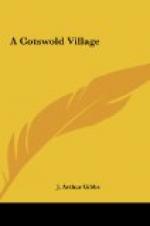Thus our Yuletide festivities passed away, all enjoying themselves immensely, and thus was sealed the bond of fellowship and of goodwill ’twixt class and class for the coming year.
Whilst the younger folks danced, the fathers of the hamlet walked on tiptoe with fearful tread around the house, looking at the faded family portraits. I was pleased to find that what they liked best was the ancient armour; for said they, “Doubtless squire wore that in the old battles hereabouts, when Oliver Cromwell was round these parts.” On my pointing out the picture of the man who built the house three hundred years ago, they surrounded it, and gazed at the features for a great length of time; indeed, I feared that they would never come away, so fascinated were they by this relic of antiquity, illustrating the ancient though simple annals of their village.
I persuaded the head of our mummer troop to write out their play as it was handed down to him by his predecessors. This he did in a fine bold hand on four sides of foolscap. Unfortunately the literary quality of the lines is so poor that they are hardly worth reproducing, except as a specimen of the poetry of very early times handed down by oral tradition. Suffice it to say that the dramatis personae are five in number—viz., Father Christmas, Saint George, a Turkish Knight, the Doctor, and an Old Woman. All are dressed in paper flimsies of various shapes and colours. First of all enters Father Christmas.
“In comes I old
Father Christmas,
Welcome in or
welcome not,
Sometimes cold
and sometimes hot.
I hope Father
Christmas will never be forgot,” etc.
Then Saint George comes in, and after a great deal of bragging he fights the “most dreadful battle that ever was known,” his adversary being the knight “just come from Turkey-land,” with the inevitable result that the Turkish knight falls. This brings in the Doctor, who suggests the following remedies:—




